List of World Heritage Sites in the Netherlands facts for kids
Imagine places so special they are protected for everyone to enjoy! These are called World Heritage Sites. They are chosen by UNESCO, which stands for the United Nations Educational, Scientific and Cultural Organization.
A World Heritage Site can be important for its cultural heritage or its natural heritage. Cultural sites include amazing buildings, sculptures, or old ruins. Natural sites are special places in nature, like unique landscapes or homes for rare animals and plants.
The Netherlands agreed to protect these sites in 1992. This means its historical and natural places could be added to the list.
Today, the Kingdom of the Netherlands has 13 World Heritage Sites. Eleven of these are in the Netherlands itself. One is on the island of Curaçao in the Caribbean. The Netherlands and Curaçao are both parts of the Kingdom of the Netherlands.
Most of these sites (eleven) are cultural. Only one is a natural site. The first site added was Schokland and Surroundings in 1995. Some sites are shared with other countries. The Wadden Sea is shared with Denmark and Germany. The Colonies of Benevolence are shared with Belgium. The Lower German Limes is shared with Germany.
There are also two places on a "tentative list." This means they might become World Heritage Sites in the future. One is in the Netherlands, one in Curaçao, and one in Bonaire. Bonaire is a special municipality of the Netherlands in the Caribbean.
Contents
Amazing World Heritage Sites in the Netherlands
UNESCO uses ten special rules, or "criteria," to pick World Heritage Sites. Each site must meet at least one of these rules. Rules 1 to 6 are for cultural sites. Rules 7 to 10 are for natural sites. * Transnational site
| Site Name | Picture | Location | Year Listed | UNESCO Number | What Makes It Special |
|---|---|---|---|---|---|
| Schokland and Surroundings |  |
Noordoostpolder, Flevoland | 1995 | 739; iii, v (cultural) | Schokland shows how people in the Netherlands fought against the sea. It was a piece of land lived on since ancient times. It became an island in the 1400s. Then, in 1859, the Zuiderzee sea completely covered it. In the 1940s, the Noordoostpolder was created. This made Schokland land again. |
| Dutch Water Defence Lines | 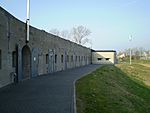 |
North Holland, Utrecht, South Holland and North Brabant | 1996 | 759bis; ii, iv, v (cultural) | The defence line of Amsterdam was built from 1883 to 1920. This defense system used water to protect the city. It has 45 armed forts. It could flood polders (low-lying land) for 135 km around Amsterdam. It was first listed in 1996. In 2021, it grew to include 9 more defense spots. It was then renamed the Dutch Water Defence Lines. |
| Mill Network at Kinderdijk-Elshout | 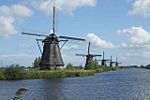 |
Alblasserdam and Nieuw-Lekkerland, South Holland | 1997 | 818; i, ii, iv (cultural) | This site shows how humans created land by draining water from polders. People started building water systems in the Middle Ages. They wanted to create land for farming and living. This area has old and new drainage channels. It also has dikes, 3 pumping stations, and 19 windmills. Most windmills were built between 1738 and 1740. |
| Historic Area of Willemstad, Inner City and Harbour, Curaçao |  |
Willemstad, Curaçao | 1997 | 819; ii, iv, v (cultural) | Willemstad was started in 1634 by Dutch traders. The city today has many old areas. These areas show a mix of Dutch, Spanish, Portuguese, and Afro-Caribbean cultures. Many old houses are painted in bright colors. This tradition began in the early 1800s. |
| Ir.D.F. Woudagemaal (D.F. Wouda Steam Pumping Station) | 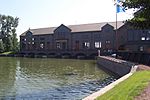 |
Lemmer, Lemsterland, Friesland | 1998 | 867; i, ii, iv (cultural) | The Wouda Steam Pumping Station stops floods in low-lying areas of Friesland. It began working in 1920. When it was built, it was the biggest and most advanced steam pumping station in the world. It was still fully working when it became a World Heritage Site. |
| Droogmakerij de Beemster (Beemster Polder) |  |
Beemster, North Holland | 1999 | 899, i, ii, iv (cultural) | The Beemster Polder was the first polder made by taking land from a lake. It was drained in 1612. This was possible because windmills had improved. The polder was laid out in a perfect grid pattern. This followed Renaissance planning ideas. Roads and waterways run north-south and east-west. The polder is still used for farming today. |
| Rietveld Schröderhuis (Rietveld Schröder House) | 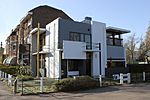 |
Utrecht, Utrecht | 2000 | 965; i, ii (cultural) | The Rietveld Schröder House was built in 1924. Truus Schröder-Schräder asked Gerrit Thomas Rietveld to design it. This house is a famous example of the De Stijl art movement. It is a small family home. Its inside layout could be changed easily over time. In the 1970s and 1980s, it was carefully fixed to look like new. Now, it is a museum. |
| The Wadden Sea* | 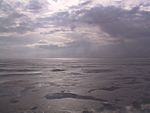 |
Friesland, Groningen, and North Holland | 2009 | 1314; viii, ix, x (natural) | The Wadden Sea is the world's largest area of sand and mud flats that are uncovered at low tide. It is very important for biodiversity. Many animals live here, like harbour seals, grey seals, and harbour porpoises. Parts of the Wadden Sea in Germany and the Netherlands were listed in 2009. The part in Denmark was added in 2014. |
| Seventeenth-century canal ring area of Amsterdam inside the Singelgracht |  |
Amsterdam, North Holland | 2010 | 1349; i, ii, iv (cultural) | The Amsterdam Canal District was planned in the late 1500s. It was built in the 1600s as a new port city. The canals form circles, with other waterways and streets crossing them. Most of the houses from the 1600s and 1700s are still there. Amsterdam's design was a model for other cities around the world. |
| Van Nelle Factory |  |
Rotterdam, South Holland | 2014 | 1441; ii, iv (cultural) | This factory was built in the 1920s. It processed and packed coffee, tea, and tobacco. It was designed by Leendert van der Vlugt. The factory shows a new idea for factory design. It was a symbol of modern and practical buildings between the World Wars. Its walls are made of steel and glass. This let in lots of daylight for the workers. The factory stopped making products in the 1990s. A new owner runs the property now. |
| Colonies of Benevolence* |  |
Drenthe | 2021 | 1555rev; ii, iv (cultural) | After the Napoleonic Wars in Europe, many people in the Low Countries became very poor. To help, the Society of Benevolence started in 1818. They built seven farming colonies for families, orphans, and others. This idea was new. It combined education, healthcare, and work to help the colonies support themselves. Three of these colonies are in the Netherlands: Veenhuizen, Frederiksoord (pictured), and Wilhelminaoord. One site, Wortel, is in Belgium. |
| Frontiers of the Roman Empire – The Lower German Limes* |  |
several sites | 2021 | 1631; ii, iii, iv (cultural) | The Lower German Limes was a border that protected the Roman province of Germania Inferior (Lower Germany). It ran along the Rhine River to the North Sea. These forts were built in the late 1st century BCE. They were used until the Western Roman Empire fell in the early 400s CE. The site has 102 locations. 39 of them are in the Netherlands, and the rest are in Germany. These sites include old forts, towns, roads, and other structures. A rebuilt watch tower in Vechten is shown. |
| Eisinga Planetarium in Franeker |  |
Franeker, Friesland | 2023 | 1683; iv (cultural) | The Royal Eise Eisinga Planetarium in Franeker is the oldest working planetarium in the world. It has an orrery. This is a mechanical model of the Solar System. Eise Eisinga built it between 1774 and 1781. It still works perfectly today! |
Future World Heritage Sites: The Tentative List
Countries can also make a list of places they might want to nominate later. This is called a "tentative list." A site must be on this list before it can be chosen as a World Heritage Site. The Netherlands has two sites on its tentative list.
| Site Name | Picture | Location | Year Listed | UNESCO Criteria | What Makes It Special |
|---|---|---|---|---|---|
| Bonaire Marine Park |  |
Bonaire, Caribbean Netherlands | 2011 | vii, ix (natural) | This park covers 2,700 hectares (about 6,670 acres). It has coral reefs, seagrass beds, and mangroves. It is home to over 50 types of stony coral. More than 350 kinds of reef fish live here too. Sea turtles also lay their eggs here. These coral reefs are some of the healthiest in the entire Caribbean. |
| Plantations in West Curaçao |  |
Curaçao | 2011 | ii, iv, v (cultural) | Four plantations are on this list: Ascencion, San Juan, Savonet, and Knip. They show a special type of Dutch plantation. These plantations worked in a dry, tropical climate. They had to deal with water shortages. Unlike other Caribbean plantations, they grew many different crops, not just sugar. They used slave labor at first. They were active from the 1600s to the early 1900s. |
See also
 In Spanish: Anexo:Patrimonio de la Humanidad en los Países Bajos para niños
In Spanish: Anexo:Patrimonio de la Humanidad en los Países Bajos para niños
- List of Intangible Cultural Heritage elements in the Netherlands

